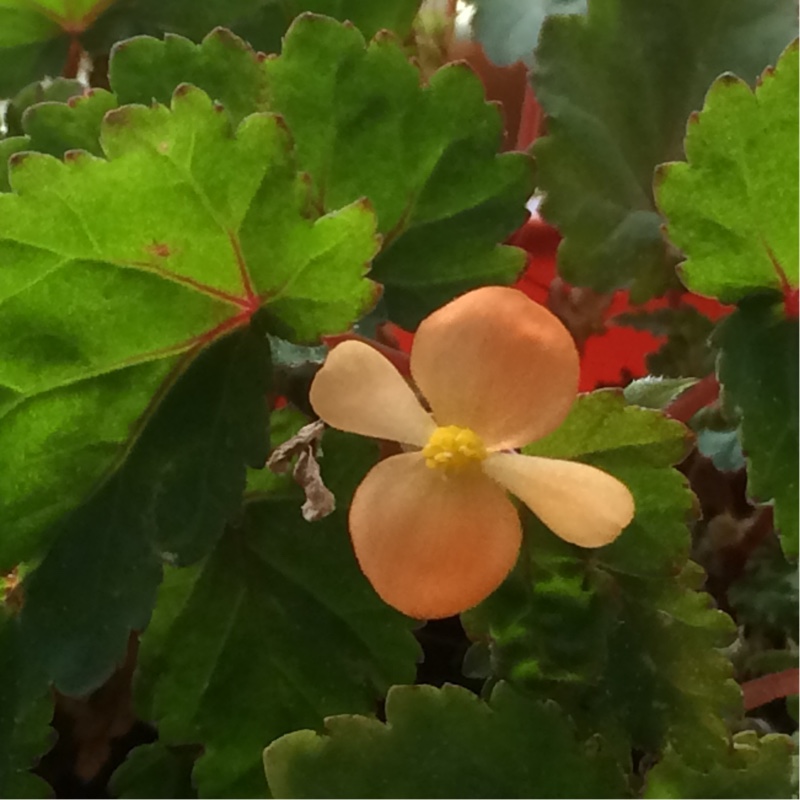
Begonia sutherlandii
Sutherland Begonia
Tuberous begonias are grown for their bright colours and long flowering season. They are suited to container growing, and for hanging-baskets. Tuberous begonias are frost-tender, and need to be lifted and over-wintered in a frost-free place, so are often grown as annuals. Sprays of flowers, each bloom up to 3cms. across, are carried on fleshy stems above the handsome coppery foliage from Summer through until Autumn. The plants grow from tubers and produce bulbils in the leaf axils from which they can be propagated. The 'Sutherland begonia' sports fleshy pink stems to 80cm long. Leaves are a dark green and veined with red and covered with short hairs on the underside. Flowers are produced in cascading panicles throughout summer.
Contributed by @tiggrx
-
Partial shade
-
Occasional watering
-
Not Frost hardy
-
Moist and free draining
Common name
Sutherland Begonia
Latin name
Begonia sutherlandii
type
Half hardy annual or perennial
family
Begoniaceae
ph
5.5 - 7.5 Acid - Neutral
Plant & bloom calendar
-
Best time to plant
full grown dimensions
 0.30 M
0.30 M
0.30 M
0.30 M
Begonia sutherlandii
Tuberous begonias are grown for their bright colours and long flowering season. They are suited to container growing, and for hanging-baskets. Tuberous begonias are frost-tender, and need to be lifted and over-wintered in a frost-free place, so are often grown as annuals. Sprays of flowers, each bloom up to 3cms. across, are carried on fleshy stems above the handsome coppery foliage from Summer through until Autumn. The plants grow from tubers and produce bulbils in the leaf axils from which they can be propagated. The 'Sutherland begonia' sports fleshy pink stems to 80cm long. Leaves are a dark green and veined with red and covered with short hairs on the underside. Flowers are produced in cascading panicles throughout summer.
Planting
From Early Spring TO Early Spring
Tubers can be started off from early spring in a heated greenhouse or a month later in a non-heated one. It is very important that a sprout appears before the tuber is planted. If your tubers seem slow to sprout, move them from the cool storage area to a warm dark place. When sprouts appear, the tubers are ready to be planted. Harden off and plant out once risk of frost has passed. It is also possible to plant the tubers directly into their flowering positions in late spring. This results in a later start to flowering. It may take up to three months from planting the tuber to full bloom, so tubers should be started indoors at least a month before the last frost date. Tuberous begonias are native to high altitudes growing conditions in the Andes Mountains. They perform best when grown in a similar environment with high humidity and cool nights. Though they need to be shaded from hot sunlight, they do need some sun to flower best. Morning light or light that is filtered through leaves or a lattice roof is best.
Propagating by stem cuttings
From Early Spring TO Mid Spring
Take a 4in (10cm) with a heel (section of tuber) in Spring. Insert in rooting compost, with some bottom heat of 18-21°C (64-70°F).
Planting
From Late Spring TO Early Summer
All begonias do best in neutral or slightly acid soils or compost, and most prefer to be sited in partial shade. Some will suffer in the sun. All begonias are frost tender. When first planting young plants, it is worth removing any early flower buds, as this will allow the plant to reach its full size as quickly as possible. Plant out bedding plants when there is no risk of frost. Water in well but as with all begonias, try to keep water away from foliage if possible as although they like to be kept moist, too much water on the foliage can cause mildew and spoil your display.
Propagation by seed early
From Mid Winter TO Late Winter
Sow seed in mid to late winter in a propogator and maintain a temperature of 20-25C. Do not cover the seed with compost. Maintain high humidity with a fine water spray. Seeds are like dust so care needs to be taken. As they begin to germinate, protect the seedlings from full direct sunlight and prick out after about six weeks. Begonias are among the more difficult plants to raise from seed. Even gardeners with well heated greenhouses often resort to buying small young plants in early or mid-spring to bring on to planting stage. Harden off before planting out.
Propagation by cutting
From Early Summer TO Late Summer
Cuttings may be propagated for additional plants. Divide in spring for more outdoor begonia plants. Cuttings can be done by taking a stem and taking off the lower leaves and making a fresh cut just under the nest leaf, dip into rooting compound and plant in a pot with damp sand to encourage roots, do not let it dry out.











